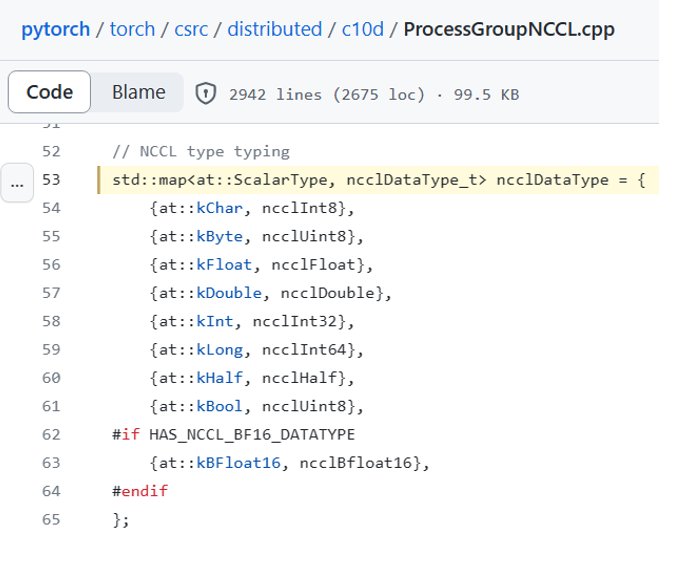I am fine-tuning Facebook's OPT-1.3B on 2x 4090 GPUs, using Ubuntu 22.04, PyTorch 2.1.0, CUDA 12.1, and HuggingFace Accelerate, using this code from the HuggingFace examples repo:
https://github.com/huggingface/transformers/blob/main/examples/pytorch/language-modeling/run_clm_no_trainer.py
When using DeepSpeed ZeRO 3 for partitioning model sizes with optimization level O3, MS-AMP crashes with this stack trace:
Traceback (most recent call last):
File "/home/alyssa/lm_fun/run_clm.py", line 769, in
main()
File "/home/alyssa/lm_fun/run_clm.py", line 583, in main
model, optimizer, train_dataloader, eval_dataloader, lr_scheduler = accelerator.prepare(
File "/home/alyssa/anaconda3/envs/lm_fun/lib/python3.10/site-packages/accelerate/accelerator.py", line 1284, in prepare
result = self._prepare_deepspeed(*args)
File "/home/alyssa/anaconda3/envs/lm_fun/lib/python3.10/site-packages/accelerate/accelerator.py", line 1667, in _prepare_deepspeed
engine, optimizer, _, lr_scheduler = deepspeed.initialize(**kwargs)
File "/home/alyssa/anaconda3/envs/lm_fun/lib/python3.10/site-packages/msamp/deepspeed/init.py", line 119, in initialize
config_class = MSAMPDeepSpeedConfig(config, mpu)
File "/home/alyssa/anaconda3/envs/lm_fun/lib/python3.10/site-packages/deepspeed/runtime/config.py", line 777, in init
self._do_sanity_check()
File "/home/alyssa/anaconda3/envs/lm_fun/lib/python3.10/site-packages/deepspeed/runtime/config.py", line 957, in _do_sanity_check
self._do_error_check()
File "/home/alyssa/anaconda3/envs/lm_fun/lib/python3.10/site-packages/msamp/deepspeed/runtime/config.py", line 40, in _do_error_check
self.zero_optimization_stage in [ZeroStageEnum.optimizer_states, ZeroStageEnum.gradients],
AssertionError: MS-AMP O3 requires ZeRO with optimizer_states or gradients partitioning.
When I switch to optimization level O2, it instead crashes with this stack trace, presumably because the MS-AMP cast.py code doesn't expect DeepSpeed's parameter partitioning:
Traceback (most recent call last):
File "/home/alyssa/lm_fun/run_clm.py", line 769, in
main()
File "/home/alyssa/lm_fun/run_clm.py", line 583, in main
model, optimizer, train_dataloader, eval_dataloader, lr_scheduler = accelerator.prepare(
File "/home/alyssa/anaconda3/envs/lm_fun/lib/python3.10/site-packages/accelerate/accelerator.py", line 1284, in prepare
result = self._prepare_deepspeed(*args)
File "/home/alyssa/anaconda3/envs/lm_fun/lib/python3.10/site-packages/accelerate/accelerator.py", line 1667, in _prepare_deepspeed
engine, optimizer, _, lr_scheduler = deepspeed.initialize(**kwargs)
File "/home/alyssa/anaconda3/envs/lm_fun/lib/python3.10/site-packages/msamp/deepspeed/init.py", line 135, in initialize
engine = MSAMPDeepSpeedEngine(
File "/home/alyssa/anaconda3/envs/lm_fun/lib/python3.10/site-packages/deepspeed/runtime/engine.py", line 304, in init
self._configure_optimizer(optimizer, model_parameters)
File "/home/alyssa/anaconda3/envs/lm_fun/lib/python3.10/site-packages/msamp/deepspeed/runtime/engine.py", line 81, in _configure_optimizer
model, basic_optimizer = msamp_initialize(self.module, basic_optimizer, optlevel)
File "/home/alyssa/anaconda3/envs/lm_fun/lib/python3.10/site-packages/msamp/init.py", line 61, in initialize
cast_model = LinearReplacer.replace(model)
File "/home/alyssa/anaconda3/envs/lm_fun/lib/python3.10/site-packages/msamp/nn/linear.py", line 176, in replace
Traceback (most recent call last):
File "/home/alyssa/lm_fun/run_clm.py", line 769, in
model = cls._replace(model, weight_qtype)
File "/home/alyssa/anaconda3/envs/lm_fun/lib/python3.10/site-packages/msamp/nn/linear.py", line 158, in _replace
setattr(model, child_name, cls._replace(child, weight_qtype))
File "/home/alyssa/anaconda3/envs/lm_fun/lib/python3.10/site-packages/msamp/nn/linear.py", line 158, in _replace
setattr(model, child_name, cls._replace(child, weight_qtype))
File "/home/alyssa/anaconda3/envs/lm_fun/lib/python3.10/site-packages/msamp/nn/linear.py", line 158, in _replace
setattr(model, child_name, cls._replace(child, weight_qtype))
[Previous line repeated 3 more times]
File "/home/alyssa/anaconda3/envs/lm_fun/lib/python3.10/site-packages/msamp/nn/linear.py", line 154, in _replace
main()
File "/home/alyssa/lm_fun/run_clm.py", line 583, in main
fp8_net = cls._build_fp8linear(model, weight_qtype)
model, optimizer, train_dataloader, eval_dataloader, lr_scheduler = accelerator.prepare(
File "/home/alyssa/anaconda3/envs/lm_fun/lib/python3.10/site-packages/accelerate/accelerator.py", line 1284, in prepare
File "/home/alyssa/anaconda3/envs/lm_fun/lib/python3.10/site-packages/torch/utils/_contextlib.py", line 115, in decorate_context
return func(*args, **kwargs)
File "/home/alyssa/anaconda3/envs/lm_fun/lib/python3.10/site-packages/msamp/nn/linear.py", line 98, in _build_fp8linear
weight = weight.cast(weight_qtype)
result = self._prepare_deepspeed(*args) File "/home/alyssa/anaconda3/envs/lm_fun/lib/python3.10/site-packages/msamp/common/tensor/tensor.py", line 703, in _cast_to_scalingtensor
File "/home/alyssa/anaconda3/envs/lm_fun/lib/python3.10/site-packages/accelerate/accelerator.py", line 1667, in _prepare_deepspeed
return ScalingTensor(TypeCast.cast_to_fp16(self, meta, sync=sync), meta=meta)
File "/home/alyssa/anaconda3/envs/lm_fun/lib/python3.10/site-packages/msamp/common/tensor/cast.py", line 81, in cast_to_fp16
meta.amax[0] = input.abs().max()
RuntimeError: max(): Expected reduction dim to be specified for input.numel() == 0. Specify the reduction dim with the 'dim' argument.
engine, optimizer, _, lr_scheduler = deepspeed.initialize(**kwargs)
File "/home/alyssa/anaconda3/envs/lm_fun/lib/python3.10/site-packages/msamp/deepspeed/init.py", line 135, in initialize
engine = MSAMPDeepSpeedEngine(
File "/home/alyssa/anaconda3/envs/lm_fun/lib/python3.10/site-packages/deepspeed/runtime/engine.py", line 304, in init
self._configure_optimizer(optimizer, model_parameters)
File "/home/alyssa/anaconda3/envs/lm_fun/lib/python3.10/site-packages/msamp/deepspeed/runtime/engine.py", line 81, in _configure_optimizer
model, basic_optimizer = msamp_initialize(self.module, basic_optimizer, optlevel)
File "/home/alyssa/anaconda3/envs/lm_fun/lib/python3.10/site-packages/msamp/init.py", line 61, in initialize
cast_model = LinearReplacer.replace(model)
File "/home/alyssa/anaconda3/envs/lm_fun/lib/python3.10/site-packages/msamp/nn/linear.py", line 176, in replace
model = cls._replace(model, weight_qtype)
File "/home/alyssa/anaconda3/envs/lm_fun/lib/python3.10/site-packages/msamp/nn/linear.py", line 158, in _replace
setattr(model, child_name, cls._replace(child, weight_qtype))
File "/home/alyssa/anaconda3/envs/lm_fun/lib/python3.10/site-packages/msamp/nn/linear.py", line 158, in _replace
setattr(model, child_name, cls._replace(child, weight_qtype))
File "/home/alyssa/anaconda3/envs/lm_fun/lib/python3.10/site-packages/msamp/nn/linear.py", line 158, in _replace
setattr(model, child_name, cls._replace(child, weight_qtype))
[Previous line repeated 3 more times]
File "/home/alyssa/anaconda3/envs/lm_fun/lib/python3.10/site-packages/msamp/nn/linear.py", line 154, in _replace
fp8_net = cls._build_fp8linear(model, weight_qtype)
File "/home/alyssa/anaconda3/envs/lm_fun/lib/python3.10/site-packages/torch/utils/_contextlib.py", line 115, in decorate_context
return func(*args, **kwargs)
File "/home/alyssa/anaconda3/envs/lm_fun/lib/python3.10/site-packages/msamp/nn/linear.py", line 98, in _build_fp8linear
weight = weight.cast(weight_qtype)
File "/home/alyssa/anaconda3/envs/lm_fun/lib/python3.10/site-packages/msamp/common/tensor/tensor.py", line 703, in _cast_to_scalingtensor
return ScalingTensor(TypeCast.cast_to_fp16(self, meta, sync=sync), meta=meta)
File "/home/alyssa/anaconda3/envs/lm_fun/lib/python3.10/site-packages/msamp/common/tensor/cast.py", line 81, in cast_to_fp16
meta.amax[0] = input.abs().max()
RuntimeError: max(): Expected reduction dim to be specified for input.numel() == 0. Specify the reduction dim with the 'dim' argument.
[2023-11-14 17:42:01,194] torch.distributed.elastic.multiprocessing.api: [ERROR] failed (exitcode: 1) local_rank: 0 (pid: 543272) of binary: /home/alyssa/anaconda3/envs/lm_fun/bin/python3
Traceback (most recent call last):
File "/home/alyssa/anaconda3/envs/lm_fun/bin/accelerate", line 8, in
sys.exit(main())
File "/home/alyssa/anaconda3/envs/lm_fun/lib/python3.10/site-packages/accelerate/commands/accelerate_cli.py", line 47, in main
args.func(args)
File "/home/alyssa/anaconda3/envs/lm_fun/lib/python3.10/site-packages/accelerate/commands/launch.py", line 979, in launch_command
deepspeed_launcher(args)
File "/home/alyssa/anaconda3/envs/lm_fun/lib/python3.10/site-packages/accelerate/commands/launch.py", line 695, in deepspeed_launcher
distrib_run.run(args)
File "/home/alyssa/anaconda3/envs/lm_fun/lib/python3.10/site-packages/torch/distributed/run.py", line 797, in run
elastic_launch(
File "/home/alyssa/anaconda3/envs/lm_fun/lib/python3.10/site-packages/torch/distributed/launcher/api.py", line 134, in call
return launch_agent(self._config, self._entrypoint, list(args))
File "/home/alyssa/anaconda3/envs/lm_fun/lib/python3.10/site-packages/torch/distributed/launcher/api.py", line 264, in launch_agent
raise ChildFailedError(
torch.distributed.elastic.multiprocessing.errors.ChildFailedError:











